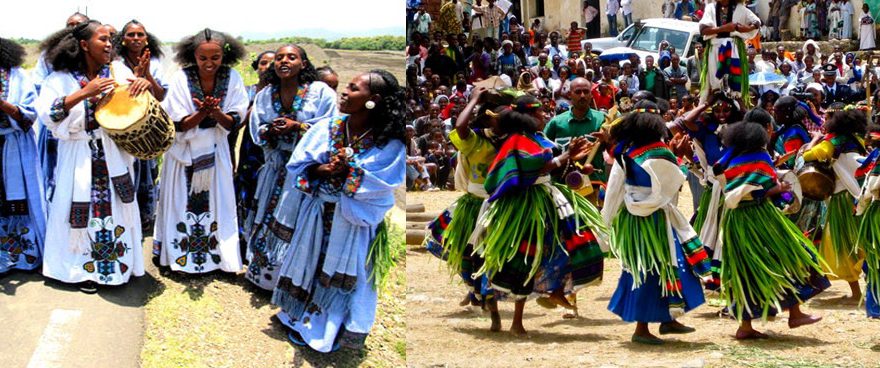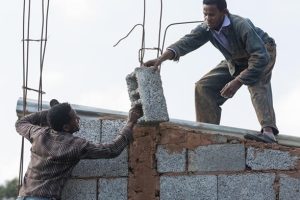
When the sunny and bright season is right around the corner and we are ready to say adieu to the three months long rainy seasons, we, Ethiopians, have our own special gender-centered cultural and religious ceremonies that we celebrate them warmly and colorfully and cherish them the most.
Especially in the month of August, as a nation where various social, cultural and religious values are entertained, including Buhe, which is said ‘boys’ festivals’, several festivals will be celebrated warmly and colorfully by unmarried girls and women.
For instance, subsequent to the end of the rainy season and the arrival of the New Year, festivals such as Ashenday, Ashandiye, Shadeye, Solel, and Shinoye are celebrated by women and girls of the Amhara, Tigray and Oromia states.
These festivals, apart from their social and cultural values, have special place among the young girls and women of Amhara, Tigray and Oromia states for they are platforms where girls and women get together, given freedom to enjoy with their friends or peers, to dance and sing for a week or so.
Starting a few days before and on the day of the New Year, girls and women prepared themselves to look more gorgeous at the event. They started beautifying themselves with homemade cosmetics, braided their hair, adorned by their traditional attires, and decorated with unique ornaments.
In fact, the festivals have different names in different areas; they will be celebrated in a manner of stimulating togetherness, a sense of sisterhood; and promoting peace and prosperity.
In Enderta and Tembien the festival is called Ashanda, and the surrounding areas; in Lasta Lalibela and Gonder it is called Ashandiye; in Waghemra Zone is called Shaday; Solel in Raya-Kobo; and Ayiniwari in Axum and the surrounding areas.
According to sources the name Ashanda/Ashandiye/Shaday stands for two things. The first is the plant which the girls knot on their waist that looks like tilted leaves, its root white and other parts being green. Ashanda/Ashandiye/Shaday also stands for the name of cultural play of the girls and women. Young girls and women, wearing traditional costumes and the knotting Ashenda grass on their waist, sing, and dance with her friends. Then they take to the streets with a hand drum for three days chanting different songs specific for that time. This is particularly true for those girls in urban areas. In rural area this chanting and dancing might remain for a month.
Shinoye is also a yearly festival celebrated by Oromo girls. Every year, girls and unmarried women gather together and sing “Yeshinoye Game” by going around neighbors’ and relatives’ houses give and receive presents.
As Journalist Naol Getachew stated in a piece titled “ብራ፡ የአዲስ ዓመት አቀባበል በኦሮሞ ባህል”, the festival is a day that women express the pressure they face from the society and the suppressive culture through poetry and music and the girls praise each other, in earlier years, parents used to give away their daughter to husband without their consents. Thus, the women use the festival as an opportunity and an independence day to express their anger towards their parents in poems.
Currently, the Ashanda, Ashandiye, Shaday and Solel festivals are being celebrated in various parts of the country. The festival is also being celebrated in Tigray State with various events under the theme “Tigray Ashenda for Peace, Recovery, and Reconstruction,” according to State’s Communication Affairs Bureau.
Speaking in relation to the festival, Tigray State Culture and Tourism Bureau said that the 2023 Ashenda festival is being marked colorfully in a way that reflects the cultural values of the people of Tigray.
Bureau Head, Atsbeha Gebreegziabher (PhD), said that the festival which is being marked with a theme “Ashenda for Peace, Recovery and Reconstruction” has focused on reflecting the economic, cultural, social and political situation of the people of Tigray in the country and abroad.
Atsebeha said that Ashenda is not an event marked only by girls but also the entire people of Tigray. While marking the day, the people of Tigray must play their role to maintain peace.
He also stated that Ashenda, Ashenda – Maria – Aini Wari’s joint diaspora celebration, a street parade and torch lighting ceremony will be held in Tigray. There will also be a discussion focusing on Ashenda festival, its cultural and religious values.
Extending his message to participants, he urged to use the festival and its theme as a tool to boost the spirit of the people and unite for the rehabilitation of Tigray. “While celebrating the festival, we must strengthen our unity; and we must work together to rehabilitate Tigray and its economy.”
Speaking at the forum, organized by Tigray Tourism and Cultural Bureau in collaboration with Mekele University, President of the Tigray State’s Interim Administration, Getachew Reda, said: “Ashenda should not only be something we can be proud of, but also a place where we can strengthen our unity and create great potential.”
A research paper, which emphasizes on using the festival as a platform to heal war affected psychology of Tigray people and strengthening the struggle for accountability and justice to ensure peace, was presented.
Since Ashenda is a special day for girls and women, it is a time where parents will let their daughters enjoy absolute freedom with their friends. For that reason whenever she returns back home there are no house chores that await her.
According to documents, Ashenda signifies the conclusion of the two-week fasting period known as Filseta, during which members of the Ethiopian Orthodox Tewahedo Church congregate to celebrate Virgin St. Mary.
BY LEULSEGED WORKU
The Ethiopian Herald August 20/2023





